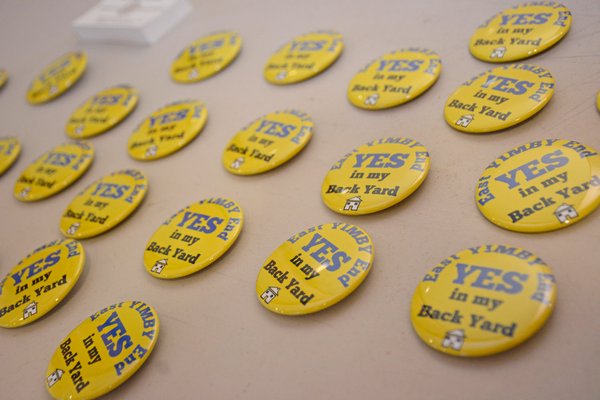
A small presentation room at the John Jermain Memorial Library in Sag Harbor was the location of an important discussion on Thursday night, August 23, concerning a big picture issue experienced on the South Fork: a lack of affordable housing.
Michael Daly, who spends his days brokering real estate trades for Douglas Elliman, led the conversation.
“I often hear, ‘We need affordable housing, but don’t put it anywhere near me,’” Mr. Daly said. That was his perspective too for awhile, but in recent years he has become a strong supporter of the “yes in my backyard,” or YIMBY, movement. It’s a counterblow to the “not in my backyard,” or NIMBY, sentiment.
“In the real estate business, I have found businesses homes to buy that they end up filling with their workers every summer because it’s so expensive out here,” Mr. Daly said, noting that doing so is also against local safety codes. In July, East Hampton Town code enforcement cited a home on Railroad Avenue for having 32 unrelated people occupying a single-family house.
Alongside Mr. Daly at Thursday’s discussion was Diana Weir, Southampton Town’s director of housing and community development. She said the growth of affordable housing units is much slower than the current need.
“In Southampton, we have about 220 units in the pipeline at different stages of construction,” Ms. Weir said. “We also have over 1,000 people on the town’s affordable housing registry. What does this mean? It means people that are born and raised here can’t afford to live here and we need to change that.”
Whether a household qualifies for affordable housing is determined based on a region’s area median income, or AMI, which is set by the U.S. Department of Housing and Urban Development. Different affordable housing opportunities will be based on various percentages of AMI.
For instance, most of the 15 affordable housing units at the Southampton Pointe condominiums on County Road 39 are reserved for households with an annual income of no more than 80 percent of the AMI for Nassau and Suffolk counties, which comes out to $93,350. The maximum price a family would pay is $233,375. A date for the housing lottery has not been set yet.
The discussion about the complex process of how affordable housing is created and sustained drew in about two dozen residents from across the South Fork. Among them was Brian Tymann, a Westhampton Beach Village trustee.
“We need to know and understand this stuff,” Mr. Tymann said. “That’s why we’ve been talking about sewering the downtown area. That will bring prime affordable housing units for mostly single people. Our downtowns are a great place for our waiters and bartenders and shopkeepers to work—and live.”
When he’s not selling a home, fulfilling his duties as a member of the North Haven Village and Southampton Town zoning boards of appeals, or on the Southampton Town Anti-Bias Task Force, Mr. Daly is co-chairing the Progressive East End Reformers NextGen Housing Collaborative, which advocates affordable housing on the East End.
He defined affordable housing as an opportunity that is “safe, suitable and does not require low-income people to spend more than 30 percent of their monthly gross income on housing,” and also housing that is protected by legally enforceable deed restrictions, affirmatively marketed and monitored by municipalities. Ideally, this housing is for a community’s working population, he said.
Naysayers—namely NIMBY advocates—contend affordable housing creates traffic, increases density, overcrowds public schools, increases taxes, limits open space, lowers property values, spikes crime and degrades the character of a town or village. To Mr. Daly, those are all just myths.
“I get it. We have this cognitive dissonance in our daily lives. But can’t you see the needs of our community growing and in need of change?” Mr. Daly asked.
He argues that affordable housing doesn’t generate any more traffic than other types of housing, helps schools attract and retain better educators and is not a “handout” for people that don’t work—without affordable housing “there would be no workforce—and instead affects seniors, lower-income people, immigrants, firefighters, military personnel, teachers and entry-level workers disproportionately.
“A lot of the myths we have about affordable housing is downright racism—but most of it is fear,” Mr. Daly said. “Section 8 people are serving your coffee and maybe teaching your children in the schools—get real people.”
Section 8 is federally subsidized housing for those at the lowest end of the income spectrum who are perhaps the most in need. Ms. Weir said there are 190 housing vouchers in Southampton. Someone who receives a voucher pays 30 percent of their income on housing while the federal government pays the rest.
Ms. Weir said that because affordable housing recipients are full-time residents, they contribute to the local economy through the taxes they pay and through what they spend at local businesses year-round.
“It’s sad because the need is there, but there is only so much that can be done,” Ms. Weir said.
As the chat winded down, Mr. Daly left the group with a fact that came as a surprise to many. Paying more than 30 percent of one’s income for housing is considered being “cost-burdened” and banks consider that in an income review for a mortgage.
“We have to take back our town and village governments instead of sitting around and waiting for politicians to do something. … We’ve got to mobilize,” Mr. Daly said pointing to his YIMBY button on his shirt as side chatter roared from the audience.